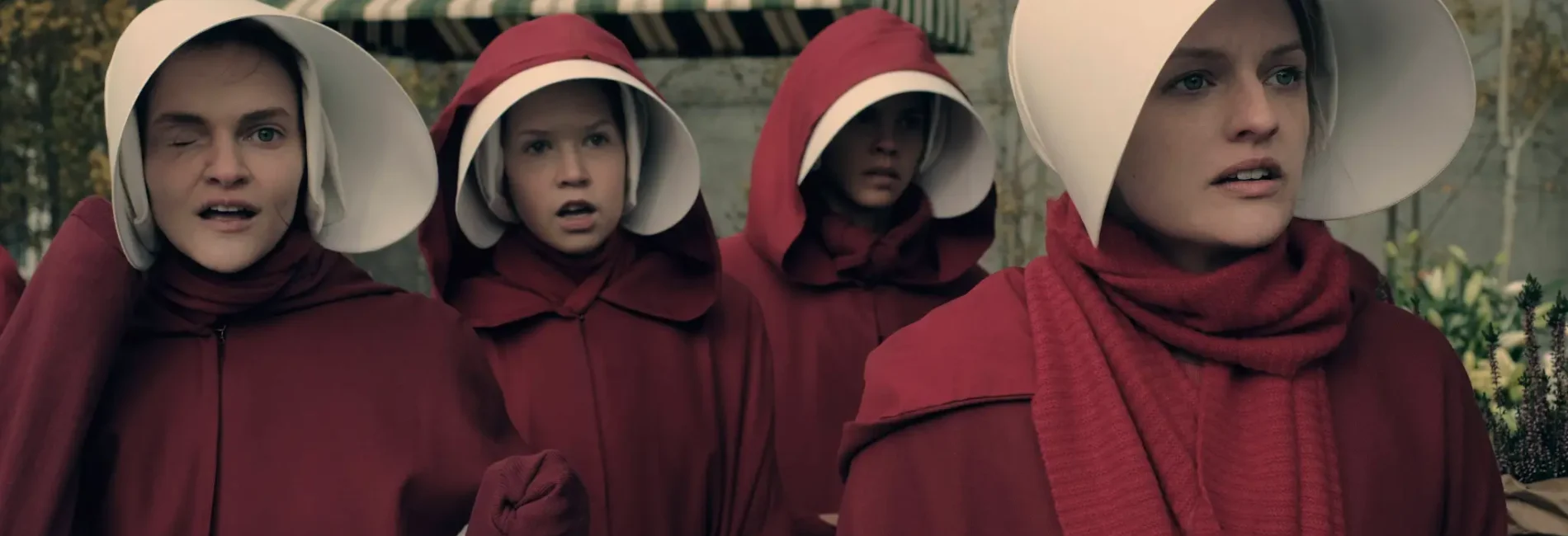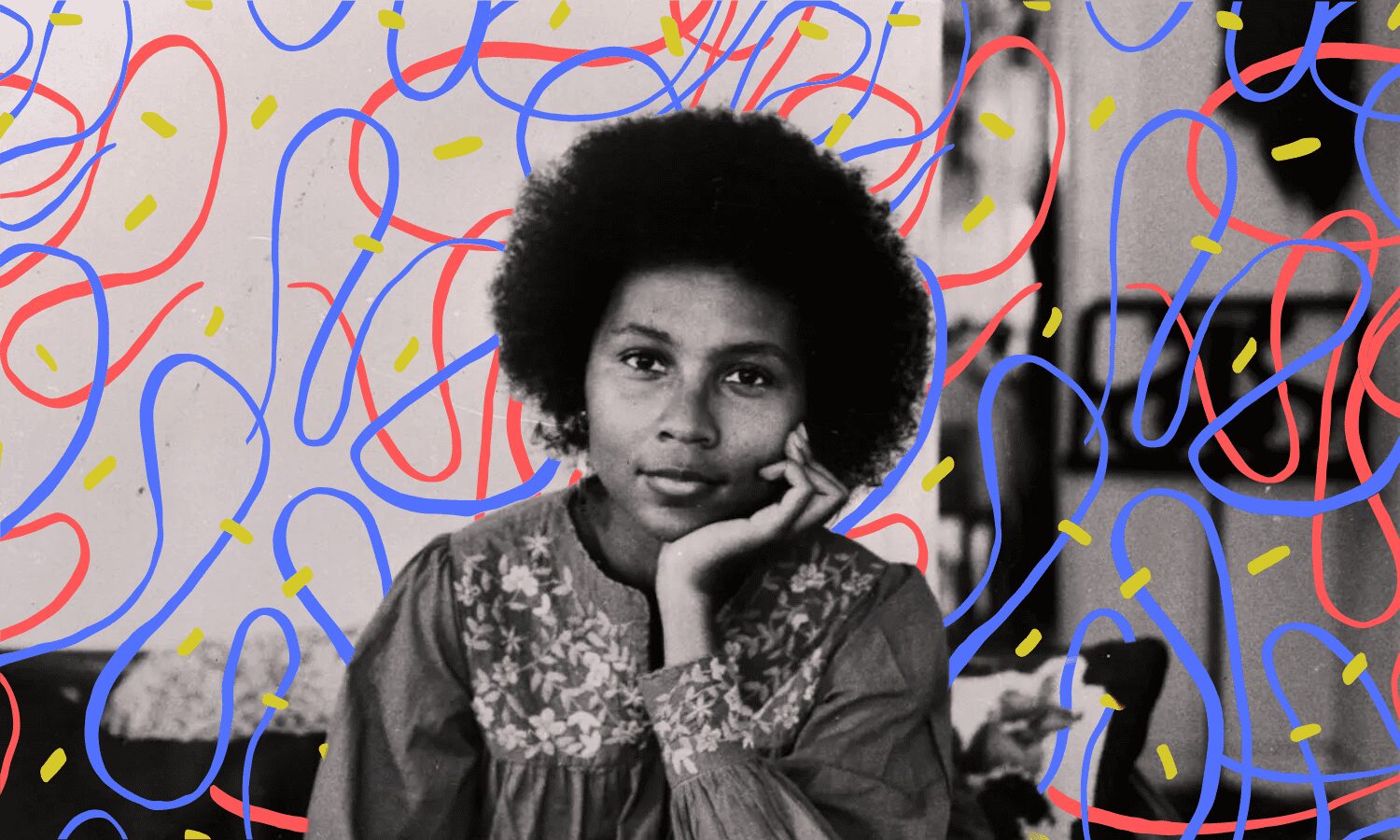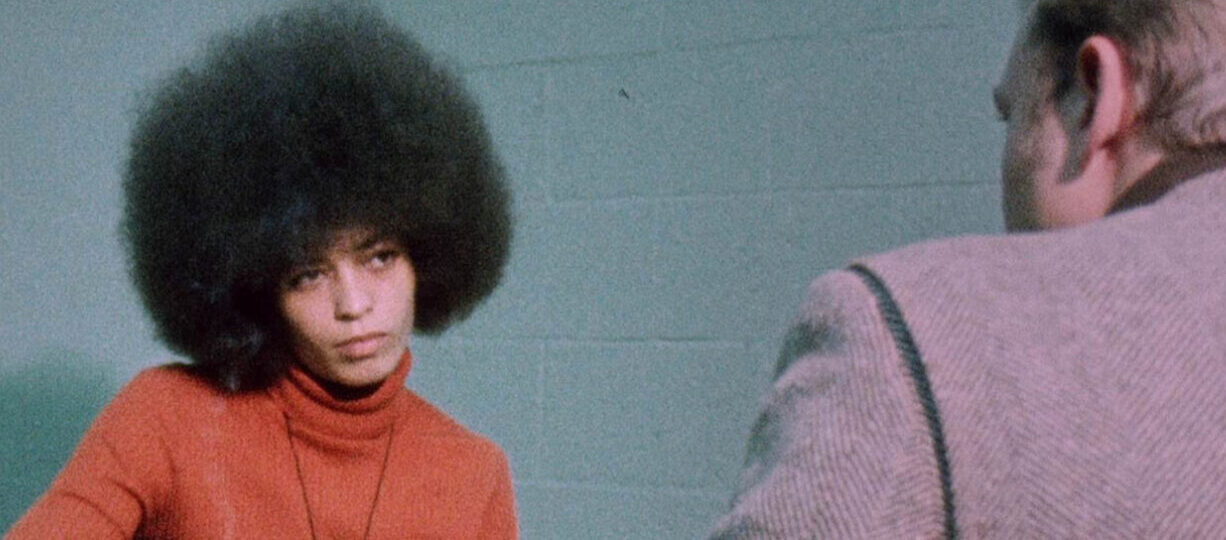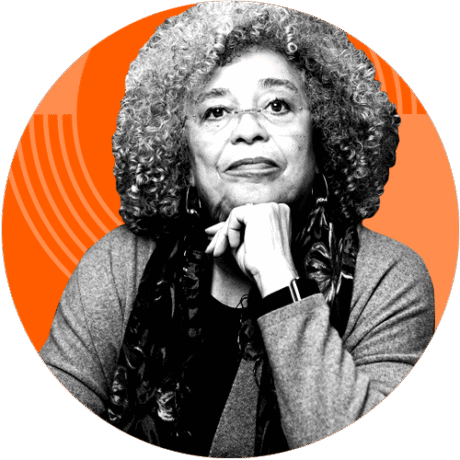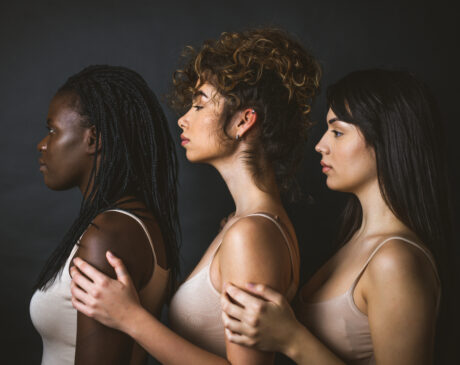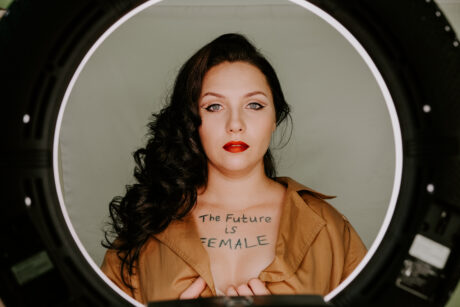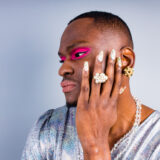From Margin to Mastery:
bell hooks, Angela Y. Davis, Gloria Anzaldúa, and the Incomplete Revolution of The Handmaid’s Tale
Margaret Atwood’s The Handmaid’s Tale is often lauded as a feminist masterpiece—a chilling dystopia that exposes the consequences of misogyny unchecked.
It’s a tale that seems more feminist-centric than most, and yet the lens in which the story is told is through the white woman’s lens demanding we impose a more critical view of the story being heralded. For those that live at the intersections of race, gender, class, and identity, The Handmaid’s Tale is also a cautionary tale about whose oppression gets visibility and whose resistance gets erased. While the novel offers a searing indictment of patriarchal control over women’s bodies, its narrative centers a very particular kind of woman: white, heterosexual, educated, and previously privileged. When read and watched through the feminist theories of bell hooks, Angela Y. Davis, and Gloria Anzaldúa, the world of Gilead becomes not only a vision of oppression but also a mirror reflecting the blind spots of white liberal feminism. These theorists challenge us to interrogate the very foundations of what we call “feminist” storytelling. They push us to ask: Whose trauma counts? Whose voice gets heard? Whose borders—physical, racial, linguistic—are crossed, erased, or policed in the name of revolution? And above all, when do we demand that more diverse stories are told?
bell hooks, in her landmark work Feminist Theory: From Margin to Center (1984), dismantles the idea that gender can be examined in isolation. “Feminism in the United States,” she writes, “has never emerged from the women who are most victimized by sexist oppression” (hooks, 1984, p.1). This line could be a direct critique of The Handmaid’s Tale, a novel and series that centers white, middle-class women whose suffering becomes the narrative focus only after they lose their rights.This approach offers a systemic look at how institutionalized oppression really is, as well as making a poignant criticism of how intersectionality is a mirror rarely reflected in modern day media. hooks would likely argue that Atwood’s portrayal of dystopia begins too late. Gilead is imagined as a catastrophic new world—but for many women—especially Black, brown, queer, and working-class women—the world has already been catastrophic.
hooks’ school of feminist thought is rooted in intersectionality and the dismantling of structural power. While Kimberlé Crenshaw coined the term, hooks lived it, insisting on a feminism that is not just about gender equality but about transforming the systems of racism, capitalism, and imperialism that shape gender oppression. In the context of Gilead, hooks would ask: Where are the women of color? What is their position in this regime? And why is June’s story the one that gets told? One of the most glaring examples of this erasure is seen in the Hulu series adaptation. The visual landscape of Gilead is stark, rigid, and haunting. In Season 1, Episode 1 (“Offred”), we see the newly formed Gileadean guards hunt down June and her family as they try to escape across the border. The cinematography is chilling—but June’s fear is new in that it is showing the oppression and assault of an ambiguous white woman instead of women of color. For many women of color in America, such state-sanctioned violence is historical and ongoing. We have seen it as recently as the women ICE is currently hunting down and kidnapping under the guise of “public safety”.
To expand on what hooks (1981) writes in Ain’t I a Woman, “It is obvious that many women have appropriated feminism to serve their own ends, especially those white women who have been at the forefront of the movement; but rather than resigning myself to this appropriation I choose to re-appropriate the term ‘feminism,’ to focus on the fact that to be ‘feminist’ in any authentic sense of the term is to want for all people, female and male, liberation from sexist role patterns, domination, and oppression.” June, in many ways, represents that desire. She wants her old life back—not necessarily a more just world. Throughout the series, we see June’s resistance build, but regardless of the rebellion, audiences are cautioned not to forget she comes from privilege.
When read through the feminist theories of bell hooks, Angela Y. Davis, and Gloria Anzaldúa, The Handmaid’s Tale becomes not only a stark (yet tangible) vision of oppression—but also a portrait of white feminism’s limitations. These feminist scholars demand that we interrogate the foundation of feminist storytelling, asking: Whose trauma counts? Whose resistance is uplifted? And what happens when those in the margins are left out of the revolution? Each of these feminist thinkers—hooks, Davis, and Anzaldúa—offers a framework that reveals the silences and exclusions within Atwood’s dystopia.
When these theories are applied to specific scenes from the Hulu adaptation of The Handmaid’s Tale, we see a fuller, more critical lens to view gender oppression, reproductive injustice, and the cultural erasure of marginalized identities.
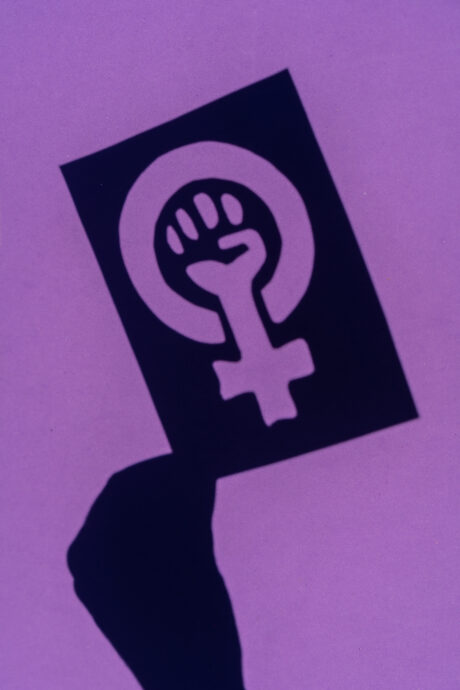
bell hooks is an intersectional feminist who dismantles the idea that gender can be understood in isolation from race, class, and other structures of oppression. In her groundbreaking work Feminist Theory: From Margin to Center, hooks; full sentence says, “Feminism in the United States has never emerged from the women who are most victimized by sexist oppression. Women who are most victimized have not been participants in the formulation of feminist theory” (hooks, 1984, p. 1). That line alone capitulates a story that only begins once white, middle-class women lose their rights. For many women—especially Black, brown, poor, or queer women—this “dystopia” has always been a reality.
To revisit Episode 1 of the Hulu adaptation, June (“Offred”) is ripped from her family and placed in the Red Center. The Red Center represents the ultimate sexist hierarchy that exists among classes, social castes, and physical traits. It is here that June is trained, alongside other women, to become a handmaid—a vessel of reproduction for the state. The significance of this in modern day politics is crucial to seeing the structural layers of built-in sexist oppression and patriarchal domination. The trauma she experiences is undeniable, but hooks would remind us that this violence is not new, maybe it’s just new-ish to white women (despite the fact that audiences will likely miss that altogether). June appears to have had the luxury of not thinking about power or politics before; certainly the luxury of not being dominated by them. She was a book editor, married to a Black man, mothering a mixed race daughter, living a relatively comfortable life. The viewer is thrust into panic alongside her, but hooks would ask: Where was this urgency when the most vulnerable women were already being denied bodily autonomy? Does it take seeing a white woman suffer to finally recognize the engrained social structures of institutionalized misogyny?
hooks also argues that feminism must actively resist systems of imperialism, racism, and capitalism—not simply patriarchy. To reference hooks’ statement in Ain’t I A Woman, “White women have not abandoned their desire to remain on top… they want equal access to the dominant male power structure” (hooks, 1981, p. 119). That sentiment surfaces clearly in June’s early resistance, which centers around reclaiming her personal agency and family—not dismantling the Gileadean system for everyone. In this way, June’s feminism is nostalgic. She wants her life back, not necessarily a more just world. And that’s the danger hooks warns us about: a feminism that seeks individual power but not collective liberation.
Furthermore, the absence of racial stratification in Gilead is deeply problematic. In both the novel and the show, race is largely erased. This silence is not just an oversight—it is, as hooks might argue, a form of psychological violence. Gilead, if modeled after American authoritarianism, would certainly reinforce white supremacy, which in essence it does. Yet we rarely see how race affects handmaids differently. Moira, June’s best friend and one of the only Black characters, is portrayed as a rebel—but even her story is filtered through June’s perspective. We learn about Moira’s trauma only as it affects June. This centering of white voices, even in resistance, is precisely what hooks identifies as the flaw of mainstream feminism.
Angela Y. Davis brings us deeper into the historical roots of reproductive oppression. A scholar and activist grounded in Black Marxist feminism, Davis sees reproductive control not as a dystopian nightmare but as a lived reality for Black women in America. And we see it playing out every day in real time. In “Outcast Mothers and Surrogates,” Davis (1990) writes, “The reproductive role imposed upon African slave women bore no relationship to a subjective project of motherhood.” (p. 448). This undeniably resonates with Gilead’s treatment of handmaids. Fertile women are forced to reproduce for elite families, stripped of autonomy, and renamed in service to their Commanders—Of-Fred, Of-Warren, Of-Joseph.
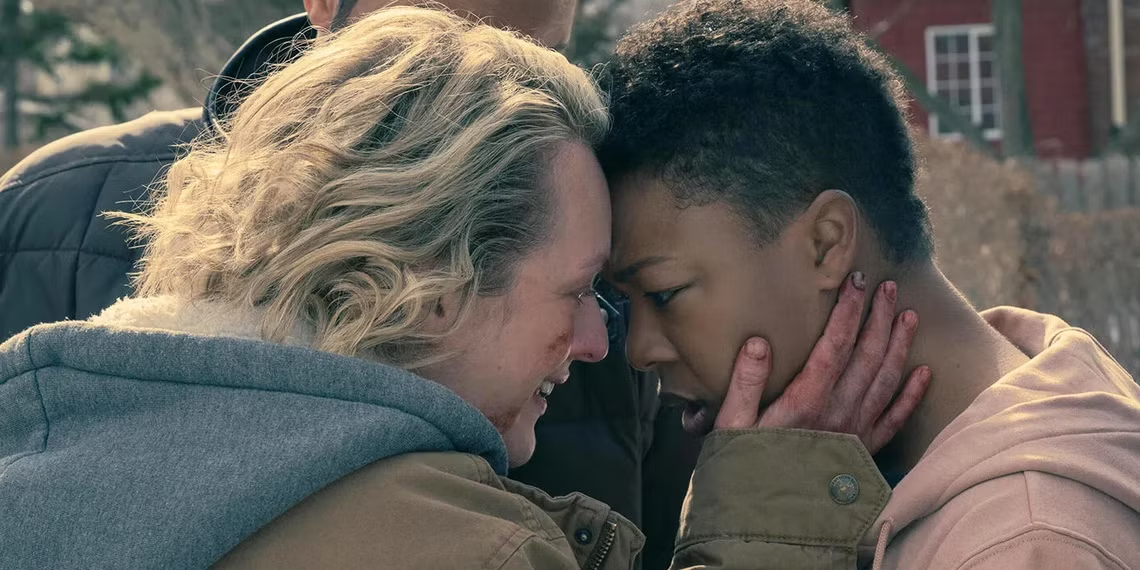
In Season 1, Episode 10 (“Night”), we see Janine, a handmaid suffering from psychological trauma, refuse to surrender her child to her Commander and his wife. She stands on a bridge, baby in arms, desperate and broken. While the scene is powerful, Davis would argue that it erases the long-standing history of Black women having their children stolen and their mothering devalued. Gilead is a whitewashed memory of Black pain—a dramatization of something many women of color already know intimately.
Davis’s theory of reproductive justice expands the feminist lens beyond abortion rights to include the right to have children, not have children, and parent children in safe environments. This framework was developed by Black women activists in response to the limitations of mainstream (white) feminism. In The Handmaid’s Tale, the entire conversation around reproduction is state-centered. The handmaids are punished for infertility, assigned based on their biological potential, and offered no say in their futures. But Davis would ask us to consider: What about women who were already living under state surveillance and family separation, such as incarcerated mothers or immigrant women at the border? We don’t see these stories in Gilead because Atwood—and the show—largely omit race from the equation. Davis would critique this as a form of historical amnesia. Gilead doesn’t represent a radical departure from American history; it is its logical conclusion. And if we fail to name the racialized nature of reproductive control, we absolve the systems that have always treated certain women’s bodies as expendable commodities.
Now I'm awake to the world. I was asleep before. That's how we let it happen. When they slaughtered Congress, we didn't wake up. When they blamed terrorists and suspended the Constitution, we didn't wake up then either. They said it would be temporary. Nothing changes instantaneously. In a gradually heating bathtub, you'd be boiled to death before you knew it.
June, Season 1, Episode 3.
Gloria Anzaldúa introduces a critical dimension to our analysis by focusing on the fluidity of identity, culture, and resistance. In her seminal work Borderlands/La Frontera, Anzaldúa (1987) articulates the concept of “mestiza consciousness,” a state of being that emerges from living between cultures, languages, and norms. She writes, “The new mestiza copes by developing a tolerance for contradictions, a tolerance for ambiguity… She learns to juggle cultures. She has a plural personality, she operates in a pluralistic mode—” (p. 79).
Anzaldúa’s work is particularly resonant when we consider the erasure of queer, bilingual, and hybrid identities in Gilead. The regime seeks to flatten complexity into binaries: male/female, fertile/infertile, pure/impure. But as Anzaldúa would argue, the act of survival often lives in the liminal spaces—the places between fixed definitions. Moira, a queer Black woman, embodies this tension. She exists in opposition to Gilead’s binaries, and her resistance is deeply tied to her refusal to conform. In Episode 3, “Late,” we witness Moira escape the Red Center disguised as an Aunt. Her use of costume, deception, and performance becomes an act of mestiza consciousness—of moving between roles to survive a system built to erase her.
Likewise, the “Unwomen” of the colonies—those deemed unfit to reproduce—symbolize those cast out of dominant norms, forced to perform brutal labor at what is more concentration camp than anything. Anzaldúa would recognize their forced exile as an extension of societal border-making, where those who don’t fit the mold are discarded like human vessels with no use. The “borderlands” of Gilead are not geographical but social—lines drawn around gender conformity, sexuality, and purity.
Anzaldúa’s insistence on hybridity and multiplicity challenges the show’s narrow portrayal of womanhood. Gilead defines femininity through reproductive capacity, erasing trans, nonbinary, and nonconforming identities. Anzaldúa’s vision of feminism is expansive—it resists borders and binaries. As she writes, “The answer to the problem between the white race and the colored, between males and females, lies in healing the split that originates in the very foundation of our lives, our culture, our languages, our thoughts. A massive uprooting of dualistic thinking in the individual and collective consciousjess is the beginning of a long struggle, but one that could, in our nest hopes, bring us to the end of rape, of violence, of war” (Anzaldúa, 1987, p. 80). This is where The Handmaid’s Tale falls short. Its resistance is often framed as a binary conflict—women vs. men, rebels vs. the state—without embracing the radical potential of plural identities.
All three theorists—hooks, Davis, and Anzaldúa—challenge the idea that The Handmaid’s Tale can be wholly embraced as feminist without critical interrogation. It critiques patriarchy, yes—but only through the lens of white, cisgender, able-bodied, heterosexual women. The show and novel often use Black and queer characters as side notes to the protagonist’s emotional journey. This centering of whiteness limits its revolutionary potential. In Season 2, Episode 13 (“The Word”), the episode is multifaceted, but one of the storylines is that Serena tries to advocate for girls’ literacy in Gilead—a small rebellion. Yet, this comes after years of her own complicity in constructing the system. The show positions her act as redemptive, but as hooks and Davis would remind us, redemption without accountability is hollow. And solidarity without intersectionality is just another form of silence. And Serena’s silence becomes the very complicity she begins with.
If The Handmaid’s Tale is to be used as a feminist text, it must be explored through the feminist theories that interrogate its blind spots. It must be read not just as a warning of what could happen, but as a reflection of what already has happened. The revolution, as Anzaldúa teaches, doesn’t happen at the center. It happens in the borderlands; Somewhere in the middle of complex patriarchal infrastructures and cultural identifiers, in the voices that were never meant to survive, and in the spaces where contradiction becomes power.
Through the lenses of bell hooks, Angela Y. Davis, and Gloria Anzaldúa, The Handmaid’s Tale is not only a cautionary tale about patriarchal rule—it is a mirror of feminism’s failures when it centers privilege and erases the margins. hooks demands that we look at who feminism has historically excluded. Davis insists we name the historical legacies of reproductive control. Anzaldúa invites us to honor multiplicity and defy the binaries imposed by power. Together, they offer a feminist framework that moves beyond survival and into solidarity. One that acknowledges pain without performance, that names trauma without commodifying it, that believes liberation is not won when the center is preserved—but when the margins are no longer margins. Because as bell hooks reminds us, “Until women accept the need for redistribution of wealth and resources in the United States and work towards the achievement of that end, there will be no bonding between women that transcends class” (hooks, 1984, p. 60). And as Anzaldúa writes, “It is imperative that mestizas support each other in changing the elements in the Mexican-Indian culture. As long as woman is put down, theIndian and the Black in all of us is put down. The struggle of the mestiza, above all, is a feminist one” (Anzaldúa, 1987, p. 84). Whether we are referring to previous feminist ideologies or modern day dystopian renderings of what some may argue is something the far right is clamoring for, the fight for true liberation can’t be waged in half measures, nor in fiction, nor in reality. Liberation from the patriarchal dominance we’re subjected to on the regular can only happen when the structural biases and injustices towards women and LGBTQ+ are banished from societal norms. Sadly, there is still a whole lot of work to be done to see feminist theories become the mainstay.
References
